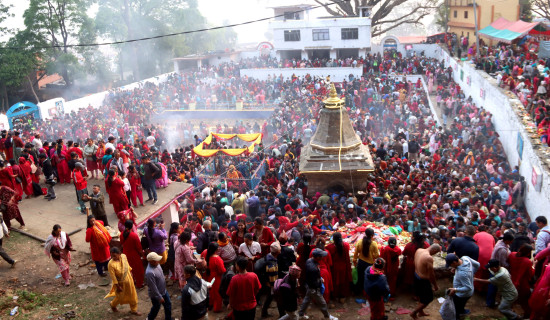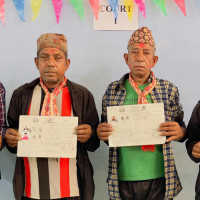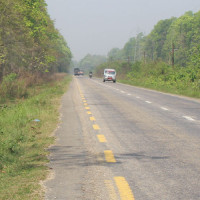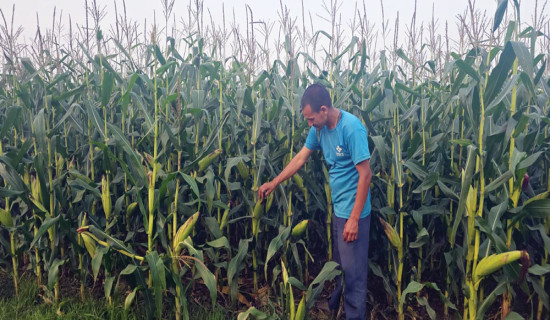- Sunday, 27 April 2025
Scorching heat disrupts life in Tarai-Madhes
By Ajay Shah,Gaushala (Mahottari), Apr. 27: For the past week, hot winds and heatwaves have been sweeping across most parts of the Tarai-Madhes. In many areas, the maximum temperature has crossed 40 degrees Celsius.
The intense heat has severely affected daily life. During the day, it is almost impossible for people to step outside. Manju Devi Yadav, a farmer from Aurahi Municipality-2, said, “We now work in the fields only early in the morning or late in the evening. Every year feels hotter than the last, but maybe it remains just how it is.”
She added, “Earlier, there were big trees where we could rest in the shade. Now, you can barely find trees.”
Sunita Kumari of Gaushala Municipality-5 said, “I applied sunscreen before leaving home, but sweat washed it all away. Even the umbrella could not block the strong sun anymore. A few minutes in the sun gives me a headache, but we have no option, apart from enduring the scorching sun.
Prembabu Yadav, a youth from Aurahi, suggested, “Just like firewood is provided and free tea is served in winter, local authorities should arrange for drinking water at street corners in summer too. Sprinkling water on roads could also help. We need awareness campaigns about how to stay safe during extreme heat.”
Bhim Bahadur Ale, who drives an auto-rickshaw in Bardibas Municipality, said, “Nowadays, it is so hot that I can only work early morning and evening. Nobody comes out during the day, and it is too exhausting to drive.” Despite the heat, he must drive to support his family, he added.
Durga Pariyar, a daily wage laborer from Bardibas-3, said that working under such extreme heat is very difficult. Without their own land, Durga and others have worked as daily wage labourers for the past 15 years. She said, “Every year, the heat feels unbearable. It is almost unbearable to work in the sweltering sun."
Daily wage laborers are finding it hard to make ends meet because it is very difficult to work during the day.
The heat has not only disrupted daily life but also made it hard for people to visit government offices. City streets and marketplaces look deserted during the daytime. Leela Kumari Magar from Gauridanda, Bardibas-3, said she has to wait until early morning or late evening to go to the market. “Stepping out in the afternoon feels like getting burnt. Even at home, the ceiling fan hardly works because of low voltage.”
For the past 10 days, schools in the Madhes region have also been affected. In many schools with tin roofs, children are drenched in sweat inside classrooms.
Although the heat poses health risks to children, private schools hesitate to close because final results have just been released. Meanwhile, public school teachers are still on strike and students spend their days playing outside in the scorching sun.
Mahottari Chief District Officer Lalbabu Kabari said discussions are underway with municipalities to consider giving school holidays. “We have urged everyone to take precautions. We are also discussing what more can be done from the government side,” he said.
Meanwhile, frequent power cuts have made life even harder. According to the Gaushala Distribution Centre of Nepal Electricity Authority, the heavy use of electrical devices in the heat has made it difficult to keep the power supply stable. Niraj Adhikari of Bardibas-1 accused the electricity authority of deliberately cutting power. “The heat is unbearable and without proper voltage, the fans barely move. During such times, electricity should be more reliable," he said.
Doctors have advised people to stay indoors or in cool places, wear light clothing, cover their heads when outside and drink plenty of water and fluids to stay safe from the heatwave. Prolonged exposure to heat can cause fatigue, weakness, thirst, dizziness, vomiting and other health risks.
According to the Meteorological Forecasting Division, temperatures from Bhairahawa to Saptari have crossed 40°C. The average temperature in all eight districts of Madhes Province has risen above 40°C, sometimes reaching as high as 42°C in the afternoon. This has emptied streets, markets and government offices during the day.
The Department of Hydrology and Meteorology warned that the extreme heat is likely to continue until the monsoon season begins. However, current conditions show no signs of the monsoon arriving soon.
Doctors warned that dehydration becomes a major risk during extreme heat. Dr. Nitesh Mandal said, “In hot weather, our body loses a lot of water through sweat to regulate temperature. Without enough water, toxins build up inside, kidneys can be affected and dehydration becomes a big problem.”
Vijay Jha, former director at the Madhes Province Health Directorate, said that lack of water can cause increased body fat, weak digestion, body toxicity and pain in joints and muscles. Even those who exercise daily need to drink extra water. Drinking at least eight glasses of water daily is advised to avoid dehydration.
Experts warned that drinks like soft drinks, beer, coffee and soda may seem refreshing but can worsen dehydration. Alcohol also increases the risk of dehydration. Lack of proper hydration can impair thinking, balance and blood circulation.
















